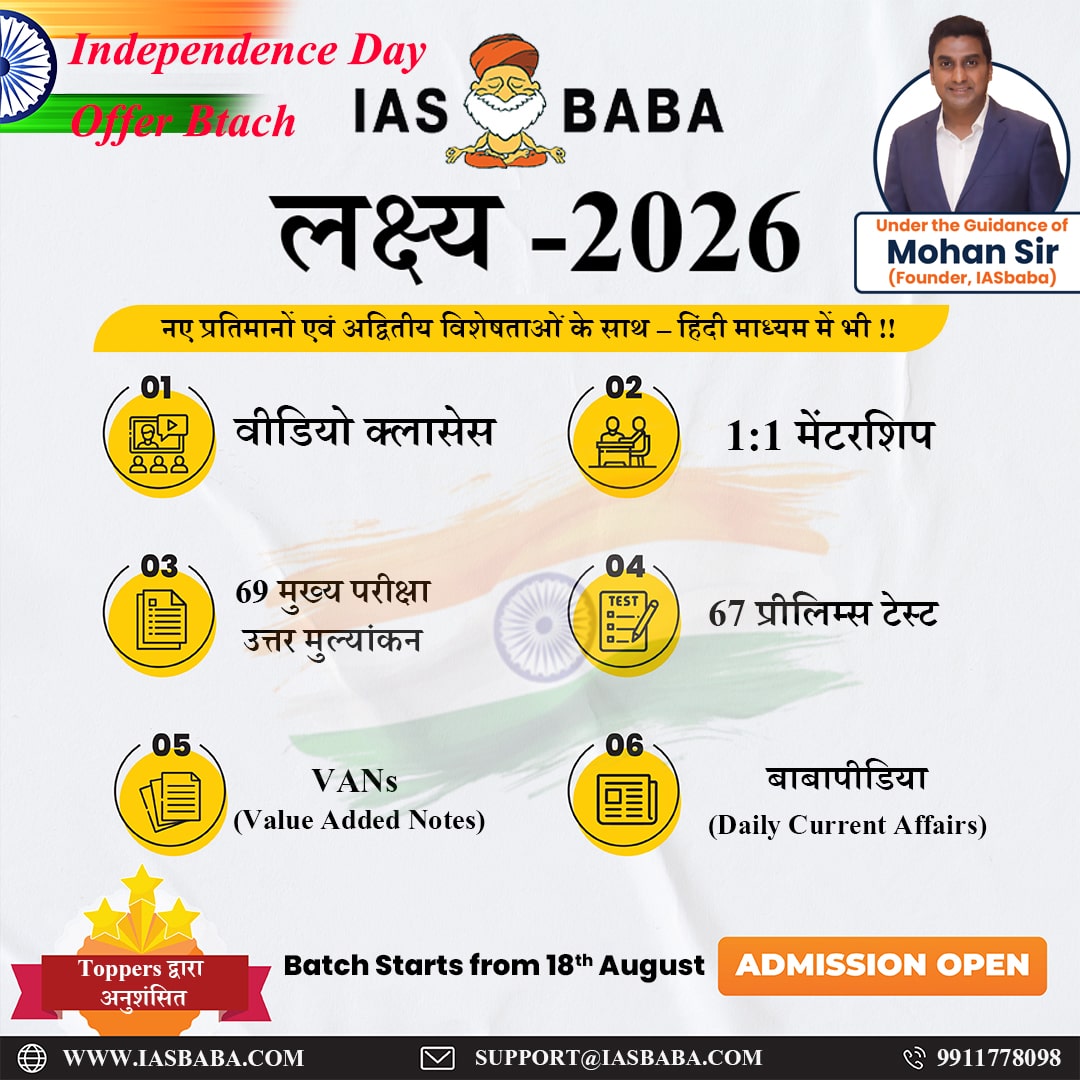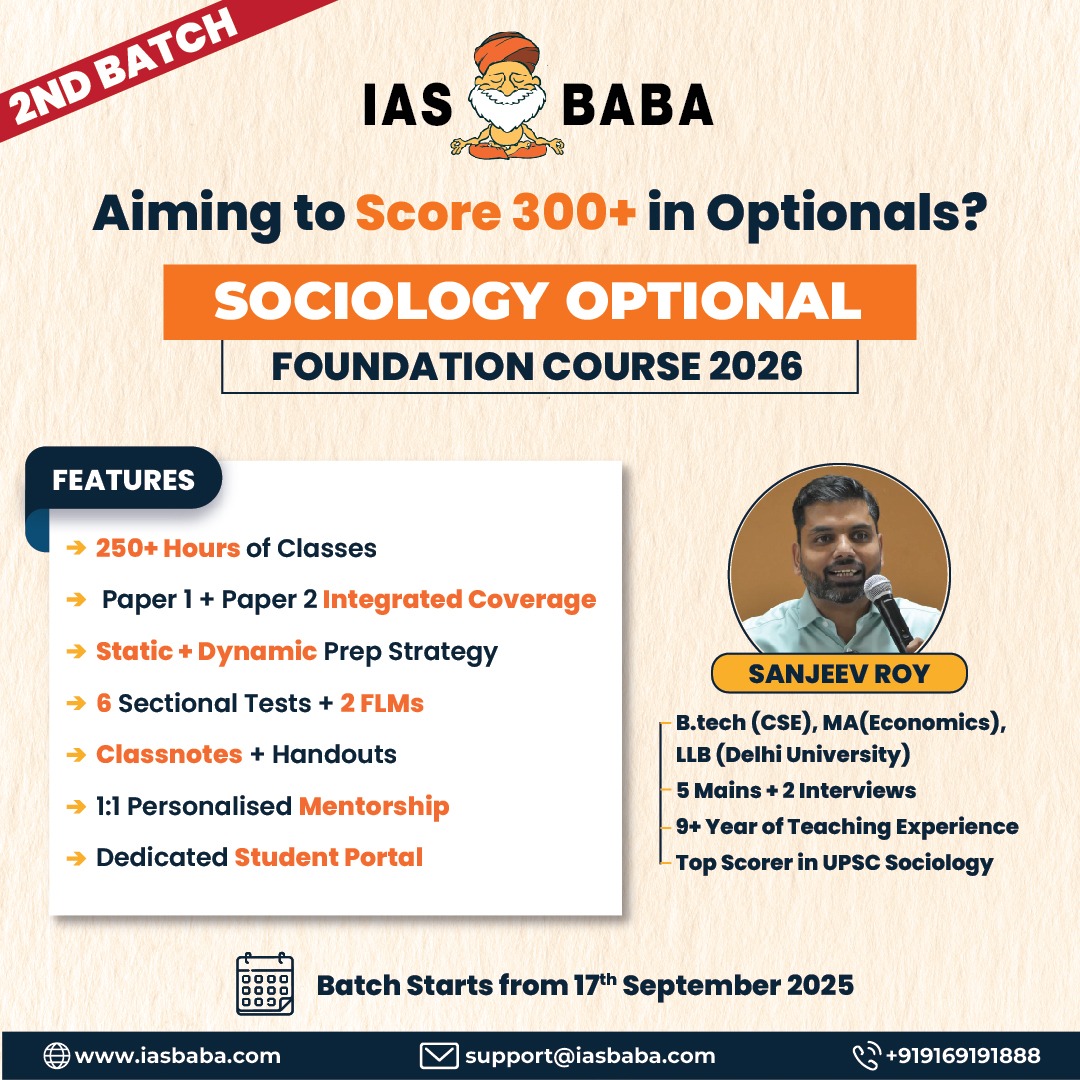IASbaba's Daily Current Affairs Analysis
Archives
(PRELIMS & MAINS Focus)
Category: POLITY
Context: Congress leader Gaurav Gogoi recently criticized the Digital Personal Data Protection (DPDP) Act, calling it “draconian” and expressing concern that it limits access to information.
Decoding the context: Other opposition leaders have also urged Union Minister Ashwini Vaishnaw to repeal Section 44(3) of the DPDP Act, arguing that it effectively dilutes the RTI framework.
Learning Corner:
- The DPDP Act propose to amend the Section 8(1)(j) of the RTI Act, 2005. This section prevents a public authority from sharing anyone’s personal information on two main grounds – that the disclosure will have no bearing on any public activity, and that revealing such information would cause unwarranted invasion of the privacy of an individual, unless such disclosure is justified in larger public interest.
- According to the proposed DPDP law, the two key grounds, that such information could be disclosed provided it serves a larger public interest, have been done away with.
- Union Minister Vaishnav, in response to the opposition claims, underlined that protection of personal information was important as the Supreme Court in the Puttaswamy judgment had held privacy to be an integral part of the Right to Life.
About RTI Act
- The RTI Act came into force in October 2005.
- Roots:
- Emerged from grassroots movements, notably the Mazdoor Kisan Shakti Sangathan (MKSS) in Rajasthan, advocating for access to government records in the 1990s.
- Built on earlier laws like the Freedom of Information Act, 2002 (never implemented) and state-level RTI laws (e.g., Tamil Nadu, 1997; Rajasthan, 2000).
- Influenced by Article 19(1)(a) of the Constitution (freedom of speech and expression), which implies the right to know.
- According to the official site of the Right to Information, “the basic object of the RTI Act is to empower the citizens, promote transparency and accountability in the working of the Government, contain corruption, and make our democracy work for the people in a real sense.” These are the four pillars of the Act.
Key Provisions of the RTI Act, 2005
- Scope: Applies to all public authorities (Central, State, and local governments, including bodies substantially funded by the government) across India.
- Process:
- Application: Citizens submit a written or electronic request to the Public Information Officer (PIO) or Assistant PIO of the concerned authority with a nominal fee (₹10; waived for BPL applicants).
- Timeline: Information must be provided within 30 days (48 hours for life/liberty matters). Appeals for non-compliance go to a First Appellate Authority (FAA) within the organization, followed by the Information Commission (Central/State).
- Penalties: PIOs face fines (up to ₹25,000) for delays, refusal, or misinformation (Section 20).
- Exemptions (Section 8):
- Information affecting national security, sovereignty, or foreign relations.
- Trade secrets, intellectual property, or personal privacy (unless public interest overrides).
- Cabinet papers and ongoing investigations (with caveats).
- Section 4: Mandates proactive disclosure of information (e.g., budgets, policies) by public authorities to reduce RTI requests.
- Information Commissions: The RTI Act, 2005, provided for a Central Information Commission and State Information Commissions to deal with appeals and complaints against public authorities.
Source : Indian Express
Category: SCIENCE & TECHNOLOGY
Context: Recently, the Digital Threat Report 2024 for the Banking, Financial Services, and Insurance (BFSI) sector was released by the Indian Computer Emergency Response Team (CERT-In), the Computer Security Incident Response Team in the Finance sector (CSIRT-Fin), and SISA, a global Cybersecurity company.
Decoding the context: The report acknowledged the targeting of crypto exchanges as a new strategy. WazirX, one of India’s major crypto exchanges, was hit by a cyber attack where hackers allegedly stole nearly half of the platform’s crypto reserves worth more than $230 million. More recently, hackers stole digital assets worth over $1.5 billion from Dubai-based crypto exchange Bybit, in what is said to be the largest crypto heist till date.
Learning Corner:
- Deepfakes and AI-generated Content: The report identifies deepfakes and AI-generated content as powerful tools for cyber intrusion, particularly in social engineering attacks.
- Prompt Hacking Risks: Prompt hacking—manipulating AI models into producing harmful or unintended responses—is more common when LLMs are hosted locally (on company servers or devices), compared to when accessed via secure APIs from providers like OpenAI (ChatGPT) or DeepSeek.
- Jailbreaking of AI Systems
- Despite using secure APIs, OpenAI’s ChatGPT has faced successful jailbreak attempts.
- Jailbraking is the process of removing software restrictions imposed by the device’s manufacturer to install unauthorized software, modify the device’s operating system, and access hidden features.
- For instance, in 2023, ChatGPT users discovered that they could bypass the AI chatbot’s safeguards by asking it to pretend to be a dead grandmother. This technique came to be known as the ‘grandma exploit’.
- Beyond jailbreaking, the report noted that malicious LLMs such as WormGPT and FraudGPT are capable of writing convincing phishing emails, coding highly effective malware programmes, and automating the development of exploits.
- The report urges policymakers to:
- Introduce clear and comprehensive regulations for AI and machine learning use in the BFSI sector.
- Mandate security testing of APIs used in AI-powered applications to detect and fix hidden vulnerabilities.
Source : Indian Express
Category: SCIENCE & TECHNOLOGY
Context: A report by the Indian Council for Research on International Economic Relations (ICRIER) has sounded the alarm over a worsening public health crisis in India: Vitamin D deficiency.
Decoding the context: With one in five Indians affected, the think tank has called for a national campaign, pricing reforms, food fortification and better diagnostics to tackle what it describes as a “silent epidemic”.
Learning Corner:
- Vitamin D is a fat-soluble vitamin essential for calcium and phosphorus absorption, and thus crucial for bone health. It also plays roles in immune function, cell growth, and inflammation reduction.
| Type | Source |
|---|---|
| D2 (Ergocalciferol) | Plant-based sources, fortified foods |
| D3 (Cholecalciferol) | Synthesized in human skin on exposure to sunlight; also from animal sources like fish, eggs, liver |
ICRIER Report Findings:
- Prevalence is highest in eastern India (38.81%), with urban areas more affected than rural ones due to lifestyle factors.
- Despite India’s abundant sunlight, deficiency is widespread due to systemic, cultural, and policy barriers.
Causes of Vitamin D Deficiency – The ICRIER report identifies multiple factors driving the crisis
- Lifestyle Changes:
- Urbanization: Indoor-centric lifestyles, high-rise buildings, and office work reduce sun exposure, especially in metros (40-60% deficiency).
- Screen Time: Increased device use among youth limits outdoor activity, particularly affecting adolescents.
- Environmental Factors:
- Pollution: High particulate matter in cities blocks UVB rays, hindering Vitamin D synthesis (e.g., Delhi’s air quality index often exceeds 300).
- Climate: Extreme summers/winters discourage outdoor activity in regions like Rajasthan or Northeast.
- Dietary Shortfalls:
- Low Intake: Only 8-14% of Indians meet recommended dairy consumption (rich in Vitamin D). Foods like fish, eggs, and fortified milk are costly or culturally avoided (60% vegetarian population).
- Lactose Intolerance: Limits milk consumption, especially in southern/eastern India.
- Unfortified Staples: Wheat, rice, and oils lack mandatory Vitamin D fortification, unlike iodized salt.
- Biological and Cultural Factors:
- Skin Tone: Darker skin (high melanin) requires 3-6 times more sun exposure for Vitamin D synthesis, a challenge for most Indians.
- Clothing Norms: Practices like burqa/purdah or full-body coverage reduce skin exposure, particularly among women.
- Sunscreen Use: Increasing use in urban areas blocks UVB rays.
- Socio-Economic Barriers:
- High Costs: Testing costs ₹1,500+, and supplements range ₹48-130 for 10 tablets, unaffordable for low-income groups. 18% GST on supplements adds burden.
- Obesity: Impairs Vitamin D metabolism, with India’s obesity rate rising (22% adults, NFHS-5).
The ICRIER report underscores Vitamin D deficiency’s far-reaching consequences
- Skeletal Disorders: 46% of children at risk of rickets; 80-90% of elderly face osteoporosis, increasing fractures and disability.
- Non-Communicable Diseases (NCDs): Linked to cardiovascular diseases (30% higher risk), type 2 diabetes (25% prevalence in adults), and cancers (e.g., breast, prostate).
- Mental Health: Associated with depression and fatigue, affecting quality of life.
- Immunity: Weakens resistance to infections (e.g., tuberculosis, COVID-19), straining healthcare systems.
- Maternal/Child Health: Deficiency in pregnant women correlates with neonatal issues (e.g., low birth weight)
Source : Down To Earth
Category: ENVIRONMENT
Context: The Central Pollution Control Board’s 2025 reclassification of waste-to-energy (WTE) incineration from a highly polluting red category to a blue category is criticized as bluewashing, falsely portraying it as an essential environmental service.
Decoding the context: Until recently, the waste-to-energy incineration industries were classified by the CPCB as a ‘red category’, a highly polluting industry.
Learning Corner:
- Bluewashing involves organizations making misleading claims about their adherence to social, economic, or ethical standards—such as human rights, labor conditions, or community welfare—to gain public trust, boost brand image, or deflect criticism, without meaningful action.
- It parallels greenwashing (misleading environmental claims) but focuses on social and economic responsibility rather than ecological concerns.
Key Mechanisms
- Tactics:
- Vague Claims: Broad statements like “committed to fairness” without measurable outcomes.
- Selective Disclosure: Highlighting minor initiatives (e.g., a single ethical product) to obscure broader issues (e.g., sweatshops).
- Symbolic Affiliations: Joining voluntary initiatives (e.g., UNGC) for branding without compliance.
- Misleading Certifications: Using unverified labels to suggest ethical practices.
- Recent Example – PepsiCo: Claimed “positive water balance” but criticized by India Resource Center (2022) for incomplete water use accounting in water-stressed Indian regions (e.g., Tamil Nadu).
Source : Down To Earth
Category: SCIENCE & TECHNOLOGY
Context: Defence Research and Development Organisation (DRDO) successfully conducted the Release Trials of Long-Range Glide Bomb (LRGB) ‘Gaurav’ from the Su-30 MKI aircraft.
Decoding the context: The Long-Range Glide Bomb ‘Gaurav’ enhances the standoff capabilities of the Indian Air Force and reflects India’s commitment to self-reliance under the Aatmanirbhar Bharat initiative in defence manufacturing.
Learning Corner:
- Gaurav is a 1,000 kg class, air-launched, precision-guided glide bomb designed to strike high-value targets at long distances with pinpoint accuracy.
- Development: Indigenously designed and developed by the Defence Research and Development Organisation (DRDO).
- Range: Capable of gliding up to 100 km when launched from high altitudes (e.g., 40,000 feet).
- Guidance System – Uses a hybrid navigation system combining:
- Inertial Navigation System (INS): Tracks position via accelerometers and gyroscopes.
- Global Positioning System (GPS): Ensures precise targeting, with potential integration of NavIC (India’s satellite navigation system) in future iterations.
About Glide Bombs
- A glide bomb is an air-launched, unpowered weapon equipped with aerodynamic surfaces (e.g., wings or fins) that enable it to glide over a long distance toward a target after release from an aircraft.
- Unlike traditional free-fall bombs, it uses precision guidance to achieve high accuracy, making it effective for standoff strikes (attacking from a safe distance).
- Key Characteristics:
- No Propulsion: Relies on the aircraft’s initial velocity and altitude for range, distinguishing it from missiles (e.g., BrahMos).
- Guidance Systems: Typically uses Inertial Navigation System (INS), GPS, or laser guidance for precision (e.g., within meters).
- Range: Varies from 30-100 km, depending on design and release altitude (e.g., Gaurav achieves 100 km).
- Warheads: Configurable for multiple targets—fragmentation (soft targets like personnel) or penetration (hardened structures like bunkers).
- Platforms: Deployed from fighter jets (e.g., Su-30 MK-I for Gaurav, Rafale, F-16 globally).
- How It Works
- Launch: Dropped from an aircraft at high altitude (e.g., 40,000 feet) and speed (e.g., Mach 0.8).
- Glide Phase: Aerodynamic wings or fins extend, allowing the bomb to glide, conserving momentum to cover long distances.
- Guidance: Onboard systems (INS-GPS, laser) track the target, adjusting flight path via control surfaces for accuracy.
- Impact: Strikes with precision, minimizing collateral damage compared to unguided bombs.
Source : PIB
Practice MCQs
Q1. With reference to Vitamin D deficiency in India, consider the following statements:
- Urban areas in India show a higher prevalence of Vitamin D deficiency than rural areas.
- Skin tone has no impact on Vitamin D synthesis from sunlight.
- Lactose intolerance is one of the factors that limits Vitamin D intake in certain regions.
- Vitamin D can be synthesized only through dietary intake and not via sunlight.
Which of the statements given above are correct?
(a) 1 and 3 only
(b) 2 and 4 only
(c) 1, 2 and 4 only
(d) 1, 3 and 4 only
Q2.The term ‘bluewashing’, often seen in the news, refers to:
(a) Overuse of water resources by industrial units without accountability.
(b) Misrepresentation of social and ethical responsibility by organizations to appear trustworthy.
(c) Artificial coloring of water bodies to hide pollution levels.
(d) A climate change adaptation practice involving seawater filtration.
Q3.Consider the following statements regarding the Long-Range Glide Bomb ‘Gaurav’:
- It is developed by the Defence Research and Development Organisation (DRDO).
- It uses propulsion to reach distant targets beyond the line of sight.
- It is launched from high-altitude aircraft and guided by an INS-GPS hybrid system.
Which of the statements given above is/are correct?
(a) 1 and 2 only
(b) 2 and 3 only
(c) 1 and 3 only
(d) 1, 2 and 3
Comment the answers to the above questions in the comment section below!!
ANSWERS FOR ’ Today’s – Daily Practice MCQs’ will be updated along with tomorrow’s Daily Current Affairs
ANSWERS FOR 11th April – Daily Practice MCQs
Q.1) – a
Q.2) – b
Q.3) – b













